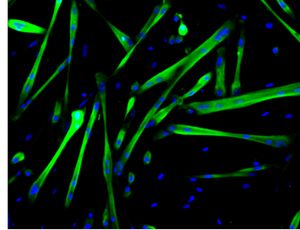
The journal JCI Insight published by the American Society for Clinical Investigation has published a paper by Prof. Józef Dulak from the JU Faculty of Biochemistry, Biophysics and Biotechnology Department of Medical Biotechnology, which discusses the issue of new mechanisms of Duchenne muscular dystrophy (DMD).
Duchenne muscular dystrophy is the most common form of muscular dystrophy, caused by a mutation in the gene that encodes dystrophin, a protein vital for the functioning of muscles, heart, and several types of cells. DMD is a DNA-related diseases (the gene is found in the X chromosome) and is found in 1 in 3,500–5,000 males. Affected people lose the ability to walk around 10–15 years or age, suffer from severe disability of pulmonary muscles and heart failure, and consequently, die prematurely. Although the underlying causes of DMD have been known for 30 years, the disease is still incurable. It is therefore necessary to seek new methods of treatment in order to at least alleviate the suffering of people affected by DMD. Recently, the team from JU Department of Medical Biotechnology has pointed out the importance of heme oxygenase 1 (HO-1), a key cytoprotective and anti-inflammatory enzyme [1, 2].
In their latest paper published in JCI Insight, the researchers have focused on the role of a small non-decoding RNA particle – microRNA-378 (miR-378) – that regulates the activity of other genes. Interestingly enough, by removing dystrophic miR-378 from mice, the scientists made them more physically capable, and their muscles were less susceptible to damage. Additionally, both in the previous and current experiments, the team has proven the importance of HO-1 and miR-378 to normal functioning of satellite cells, i.e. skeletal muscle stem cells.
The team’s research offer the possibility of searching for pharmacological factors that affect both HO-1 and miR-378, which could then be used to treat DMD.
Prof. Dulak started his research on DMD in 2013 within the framework of the Maetro grant funded by the National Science Centre. Currently, he and his team are using a second grant to continue the project. Other aspects of muscular dystrophy are being investigated by Prof. Agnieszka Łoboda (Opus grant) as well as Paulina Podkalicka, Olga Mucha and Kalina Andrysiak (Preludium grant). The research projects are being carried out in collaboration with the Neurology Clinic of the Warsaw Medical University led by Prof. Anna Kostera-Puszczyk.
1. Kozakowska i wsp. Lack of Heme Oxygenase-1 Induces Inflammatory Reaction and Proliferation of Muscle Satellite Cells After Cardiotoxin-Induced Skeletal Muscle Injury. Am J Pathol. 2018;188(2):491-506. doi: 10.1016/j.ajpath.2017.10.017.
2. Pietraszek-Gremplewicz i wsp. Heme Oxygenase-1 Influences Satellite Cells and Progression of Duchenne Muscular Dystrophy in Mice. Antioxid Redox Signal. 2018;29(2):128-148. doi: 10.1089/ars.2017.7435.





